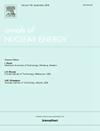Investigation on coupling methods for heat transfer field between a reactor core and heat pipes
IF 2.3
3区 工程技术
Q1 NUCLEAR SCIENCE & TECHNOLOGY
引用次数: 0
Abstract
Heat pipe reactors are inherently safe, compact, and capable of providing a reliable energy supply for remote areas. Heat pipe reactors are often designed as solid-state reactors, enabling the analysis of the reactor through the integration of multiple coupled physical fields. This paper proposes a numerical method that uses the equivalent convective coefficient to solve the coupled heat transfer problem between the reactor core and heat pipes under steady-state conditions. This method effectively reduces the number of iterations and accounts for the uneven heat absorption effects of the heat pipes at the corner and side channels on the azimuthal direction. In this study, an open-source code Multiphysics Object-Oriented Simulation Environment (MOOSE for short) is used to implement the numerical method. The findings will support the coupling analysis procedure of a heat pipe reactor core and heat pipes.
反应堆堆芯与热管传热场耦合方法研究
热管反应堆本身安全、紧凑,能够为偏远地区提供可靠的能源供应。热管反应器通常被设计为固态反应器,从而可以通过多个耦合物理场的集成对反应器进行分析。本文提出了一种用等效对流系数求解稳态条件下反应堆堆芯与热管耦合传热问题的数值方法。该方法有效地减少了迭代次数,并考虑了角部和侧通道热管在方位角方向上吸热效果不均匀的问题。在本研究中,使用开源代码的多物理场面向对象仿真环境(MOOSE)来实现数值方法。研究结果为热管堆芯与热管的耦合分析提供了理论依据。
本文章由计算机程序翻译,如有差异,请以英文原文为准。
求助全文
约1分钟内获得全文
求助全文
来源期刊

Annals of Nuclear Energy
工程技术-核科学技术
CiteScore
4.30
自引率
21.10%
发文量
632
审稿时长
7.3 months
期刊介绍:
Annals of Nuclear Energy provides an international medium for the communication of original research, ideas and developments in all areas of the field of nuclear energy science and technology. Its scope embraces nuclear fuel reserves, fuel cycles and cost, materials, processing, system and component technology (fission only), design and optimization, direct conversion of nuclear energy sources, environmental control, reactor physics, heat transfer and fluid dynamics, structural analysis, fuel management, future developments, nuclear fuel and safety, nuclear aerosol, neutron physics, computer technology (both software and hardware), risk assessment, radioactive waste disposal and reactor thermal hydraulics. Papers submitted to Annals need to demonstrate a clear link to nuclear power generation/nuclear engineering. Papers which deal with pure nuclear physics, pure health physics, imaging, or attenuation and shielding properties of concretes and various geological materials are not within the scope of the journal. Also, papers that deal with policy or economics are not within the scope of the journal.
 求助内容:
求助内容: 应助结果提醒方式:
应助结果提醒方式:


